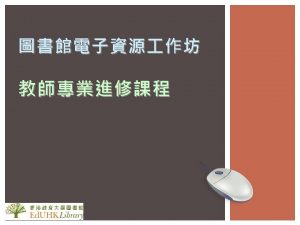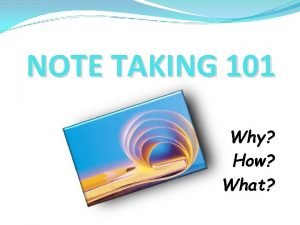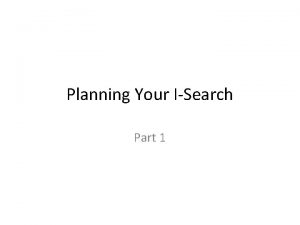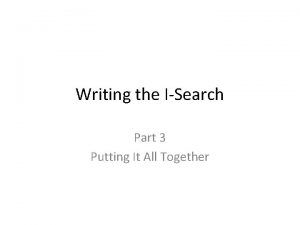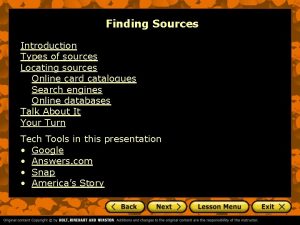Writing the ISearch Part 2 Finding Sources Taking







- Slides: 7

Writing the I-Search Part 2 Finding Sources & Taking Notes

Before you move forward on research, you need to make sure you have done/are doing the following. You will not be able to write the I-Search paper in the required style unless you have: § A topic (using Trigger Sentences from web) § A research question with four sub-questions (use the handout from the web) § Keep a journal of your search experience § What you do each day § What you thought about and think about while searching § Success and setbacks Without these pieces in place you will not be able to write a true ISearch paper.

As you conduct your search, tracking your successes and set backs in your research journal, you are looking for two types of sources: § Primary Sources § First hand experience and information—like water right from the stream § Diaries/blogs (online but must be the first-hand experience of the author) § Interviews (parents, experts) § Surveys (surveymonkey. com) § Legal documents (court records) § Letters (like blogs—first hand accts) § Eye witness accounts (probably gathered by interview) § Secondary Sources § Information presented by authors who have done previous research —like buying water that someone already collected and bottled. § Books § Magazine articles § Websites

Record Your Sources A Source to Trust? Just as members of a jury have to decide which witnesses are credible, or believable, and which are not, you have to determine the extent to which you can trust your sources of information. Here are some questions you can use to put your sources to the test. 1. Is the information up-to-date? Information is generated so quickly now that it is easy to find current material. If information on your topic is constantly changing, be sure that you are as up-to-date as possible. For example, a report on asthma medications from 1975 would not reflect current research and might be incorrect according to today’s medical standards. 2. Does the information seem factual? Check the information against your own knowledge and against other sources. If you find an inconsistency between two sources, check a third source to determine which information is accurate. 3. Does the source seem objective and logical? Some sources may be biased, or slanted, toward one point of view. Others may use poor logic. You would not, for example, expect an objective assessment of one political party’s platform from the leader of the opposing political party.

Taking Notes • The Researcher’s Best Friend Unless you are one of those fortunate people who has a photographic memory, good notes are invaluable. If you take good notes, you will have a record of the important information you will need when it is time to sit down to write your paper. • When you take notes you can quote directly, summarize, or paraphrase. To the right are examples of each of these methods used to record notes on the same passage. • I am using the I-Search note form from the website.

How many sources and notes do I need? • For full credit on the I-Search you must have at least six sources and at least one page of notes for each source. These will be turned in. • Of course, the best papers will have more notes. • Remember that you can earn up to 25 pts. extra credit for inclusion of a primary source: • Interview • Experiment • Survey

Before moving to the next presentation, make sure you have done the following • Collected information to answer your I-Search question/questions • At least six sources (extra cred for primary source) • At least 6 pages of notes using the research notes handout • Complete bibliographic references for each source (use easybib. com) • http: //www. easybib. com/help/intro • Any print outs you are using should be attached to the note handouts you submit • Have Mr. Allen check each of these steps to earn points and track progress.
